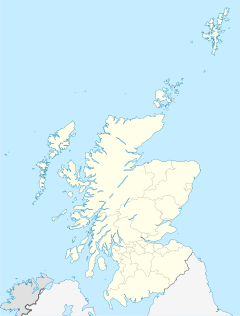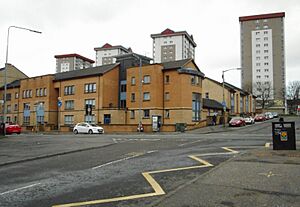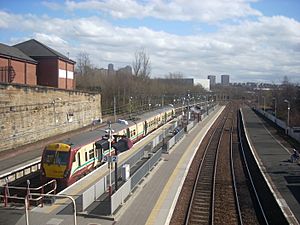Springburn facts for kids
Quick facts for kids Springburn
|
|
|---|---|
| Inner-city district | |
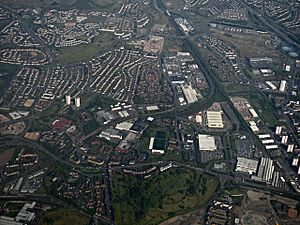 View of Springburn from aircraft looking east (2017) |
|
| Population | 12,064 (2012) |
| OS grid reference | NS607678 |
| • Edinburgh | 65 km |
| • London | 557 km |
| Council area | |
| Lieutenancy area |
|
| Country | Scotland |
| Sovereign state | United Kingdom |
| Post town | Glasgow |
| Postcode district | G21 |
| Dialling code | 0141 |
| Ambulance | Scottish |
| EU Parliament | Scotland |
| UK Parliament |
|
| Scottish Parliament | |
Springburn (Scottish Gaelic: Allt an Fhuairainn) is an inner-city area in the north of Glasgow, a large city in Scotland. It is mainly home to working-class families.
Springburn started as a small village in the early 1800s. It grew quickly when a chemical factory was built nearby in 1799. This factory was owned by Charles Tennant and was located next to the new Monkland Canal.
Later in the 1800s, new railway lines were built through the area. This led to the creation of large railway factories. Springburn then became its own parish, which is a local church area. The first railway line, the Garnkirk and Glasgow Railway, opened in 1831. It helped supply the chemical works. Another important line, the Edinburgh & Glasgow Railway, opened in 1842.
Springburn was first outside Glasgow city limits. However, the main part of Springburn joined the city in 1872. Other parts became part of Glasgow in 1891. Today, Springburn is part of the Springburn/Robroyston ward and is managed by Glasgow City Council.
Contents
Springburn's Industrial Past
Springburn's economy was strongly linked to heavy industry, especially making locomotives (train engines). At one time, Springburn's locomotive factories made a quarter of all the train engines in the world!
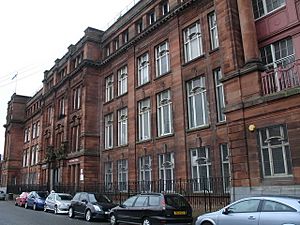
Four main railway manufacturing sites were located in Springburn:
- The North British Railway's (NBR) Cowlairs Works started in 1841.
- The Caledonian Railway's St Rollox Works opened in 1856.
- Neilson & Company's Hyde Park Works began in 1861.
- Sharp, Stewart & Company's Atlas Works opened in 1888.
The last two companies, Neilson & Company and Sharp, Stewart & Company, later joined together. They formed the North British Locomotive Company (NBL) in 1903. The Eastfield Running Shed, a place where trains are kept and maintained, was also built here in 1904.
The St Rollox Works became the largest of these factories. It is the only one still standing today. The NBL closed in 1962, and Cowlairs closed in 1968. In 2007, Railcare Limited took over operations at St Rollox. However, it closed in 2019. The former Eastfield Running Sheds are now used by ScotRail for train maintenance. Part of the old Cowlairs sidings is now a signalling and maintenance depot for Network Rail.
Another big company in Springburn was Promat UK. They made materials that protect against fire at their Germiston Works. This factory is now closed.
Community Life in Springburn
Springburn Park: A Green Space
The highest point in Springburn, and in Glasgow, is Springburn Park. It is about 364 feet (111 meters) above sea level. The park has the Springburn Winter Gardens, which has been empty since 1983. Stobhill Hospital was built next to the park in 1904.
Barnhill Poorhouse: A Look Back
The Barnhill Poorhouse in Springburn opened in 1850. This was a place where people who could not support themselves lived. They had to work at jobs like bundling firewood or breaking rocks. In 1905, it became the largest poorhouse in Scotland. In 1945, it was renamed Foresthall Home and Hospital. It was used as a hospital and home for older people. The building was taken down in the late 1980s. Now, new houses stand on that site.
Sporting Spirit in Springburn
Springburn has a history of local football teams. Cowlairs was one of the first teams to join the Scottish Football League in 1890. Another local team, Northern, also played in the league for a short time. Petershill was founded in 1897 and still plays today. They play at New Petershill Park, a modern stadium that can hold 2,000 fans.
Springburn's Modern Development
Springburn continued to grow in the 20th century. New housing areas like Balornock were built between the two World Wars. After World War II, more housing was built in Balgrayhill, Barmulloch, and Sighthill.
The old town center of Springburn was rebuilt from the 1970s to the 1980s. Many old buildings were taken down, and new housing estates were built. A major road, the A803 Springburn Expressway, was finished in 1988.
Even with these changes, Springburn faced challenges. Many jobs were lost when the railway industry declined. However, efforts have continued to improve the area. North Glasgow College (now Glasgow Kelvin College) was created in 1965.
Recently, the Keppochhill Road area has been improved. Many old sandstone flats have been renovated. New, modern low-rise houses have also been built. The West of Scotland Housing Association now has its main office here.
A notable old building, the former Public Halls, opened in 1902. It was designed by William B. Whitie, who also designed Springburn's Public Carnegie library. This library later became the Springburn Museum until it closed in 2003. The Public Halls were taken down in 2012. The old Springburn Library building is now a conference center.
Community Challenges and Support
Like many areas, Springburn has faced some community challenges. For example, in 2001, many residents did not have formal qualifications. Also, a large number of households did not own a car. These factors can make daily life harder for some families.
Reports in the early 2000s showed that some families in Springburn were experiencing poverty. The unemployment rate was also higher than the average for Scotland. These challenges highlight the need for ongoing support and development in the area.
In 2012, a study by the Scottish Government identified Keppochhill in Springburn as one of the areas with the most challenges in Scotland. A 2013 report also showed that many children in Springburn were living in poverty. These findings show the importance of community programs and support systems.
Getting Around Springburn
Springburn has two main railway stations: Springburn railway station and Barnhill railway station. These stations offer regular train services to other parts of Glasgow. The area is also served by many bus routes, including the First Bus 88 and 90.
Famous People from Springburn
Many well-known people have come from Springburn. These include:
- James McFadden, a Scottish international footballer.
- Sydney MacEwan, a famous singer.
- Craig Ferguson, a comedian, author, and talk show host.
- Tom Weir MBE and his sister Molly, who were broadcasters and writers.
- Politicians like Paul Sweeney, John McAllion, and Frank McAveety.
- Michael Martin, who was the Speaker of the House of Commons from 2000 to 2009.
Other notable locals include:
- Duncan Campbell, musician
- Peter Capaldi, actor
- Stevie Chalmers, footballer
- Marion Chesney, author
- Robert Florence, presenter
- Bobby Gillespie, musician
- Campbell Christie, trade unionist
- Karl Denver, singer
- Agnes Dollan, suffragist and political activist
- Robert Downie, World War I Victoria Cross recipient
- Valerie Edmond, actress
- Agnes Hardie, politician
- Armando Iannucci, writer
- Mo Johnston, footballer
- Anne Lacey, actor
- Markee Ledge – Kosheen, musician/songwriter/DJ
- Jimmie Macgregor, folksinger
- Gavin Mitchell, actor
- Billy Reid, footballer
- Allan Ross, footballer
Images for kids
-
Former headquarters of the North British Locomotive Company in Springburn was designed by James Miller and completed in 1909. From 1961 the building was the campus of North Glasgow College and was converted into an office complex in 2009.


